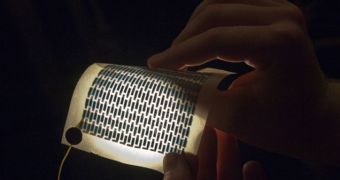Thanks to an innovation by researchers at the Massachusetts Institute of Technology (MIT), in Cambridge, experts are now capable of printing advanced photovoltaic circuits unto unconventional substrates such as paper and fabric.
If this technology is scaled up and developed further, it could soon become possible to print solar cells nearly as easily as you print a document at work. The resulting sheets of paper now look absolutely normal, with the exception that they have an array of colored rectangles printed on their surface.
Researchers casually display the sheet of paper, and then connect a LCD display to it via two wires. When the connection is established, the display lits up and displays the time. This technology, which seems to have dropped from a SF movie, is also very cheap to employ.
The MIT team explains that the active photovoltaic components in this setup were formed from specially-designed inks that were deposited in specific patterns on the paper. Experts add that the new material is also foldable.
This means you can crumple up the paper in our pocket, then stretch it and watch it produce electricity again. Conventional solar cells – which are mostly based on silicon – cannot be folded as their substrates are usually very brittle (and expensive).
Details of the new investigation appear in the July 8 online issue of the esteemed scientific journal Advanced Materials. The Eni-MIT Alliance Solar Frontiers Program and the US National Science Foundation (NSF) provided the funds for this research.
The work was led by the MIT Alexander and I. Michael Kasser professor of chemical engineering Karen Gleason, professor of electrical engineering Vladimir Bulović, graduate student Miles Barr, and a number of other students and postdoctoral researchers.
“We have demonstrated quite thoroughly the robustness of this technology. […] We think we can fabricate scalable solar cells that can reach record-high watts-per-kilogram performance. For solar cells with such properties, a number of technological applications open up,” Bulović explains.
Researchers also mention that they were successful in using the new technology on PET plastic. After folding and unfolding the sheet of material 1,000 times, the MIT team was unable to discover any significant drop in performances.
The group is also confident that the new approach can be used outdoors as well. Rain and snow can be kept at bay by coating the sheets of photovoltaic paper with standard lamination material.

 14 DAY TRIAL //
14 DAY TRIAL //